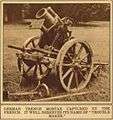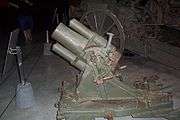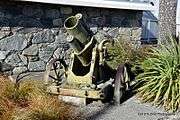17 cm mittlerer Minenwerfer
The 17 cm mittlerer Minenwerfer (17 cm mMW) was a mortar used by Germany in World War I.
| 17 cm mittlerer Minenwerfer | |
|---|---|
 17 cm Minenwerfer n/A at the Verdun Memorial, Verdun, France | |
| Type | Medium trench mortar |
| Place of origin | German Empire |
| Service history | |
| In service | 1913–1918 |
| Used by | German Empire |
| Wars | World War I |
| Production history | |
| Designer | Rheinmetall |
| Manufacturer | Rheinmetall |
| Produced | 1913–18 |
| No. built | approx. 2361 |
| Variants | 17 cm mMW n/A |
| Specifications | |
| Mass | 483 kg (1,065 lbs) |
| Barrel length | a/A: 64.6 cm (2 ft 1 in) L/3.8 n/A: 76.5 cm (2 ft 6 in) L/4.5 |
| Calibre | 170 mm (6.69 in) |
| Recoil | hydro-spring |
| Carriage | box trail |
| Elevation | +45° to 90° |
| Traverse | 25° |
| Rate of fire | 20 rpm |
| Muzzle velocity | 200 m/s (656 ft/s) |
| Effective firing range | 300 m (325 yards) |
| Maximum firing range | 1,600 meters (1,700 yd) |
| Sights | panoramic |
| Wikimedia Commons has media related to 17 cm Minenwerfer. |
Development and Use
The weapon was developed for use by engineer troops after the Siege of Port Arthur during the Russo-Japanese War of 1905. It illustrated the usefulness of this type of weapon in destroying bunkers and field fortifications otherwise immune to normal artillery. It was a muzzle-loading, rifled mortar that had a standard hydro-spring recoil system. It fired 50 kilogram (110 lb) HE shells, which contained far more explosive filler than ordinary artillery shells of the same caliber. The low muzzle velocity allowed for thinner shell walls, hence more space for filler. Furthermore, the low velocity allowed for the use of explosives like Ammonium Nitrate-Carbon that were less shock-resistant than TNT, which was in short supply. This caused a large number of premature detonations that made crewing the minenwerfer riskier than normal artillery pieces.
A new version of the weapon, with a longer barrel, was put into production at some point during the war. It was called the 17 cm mMW n/A (neuer Art) or new pattern, while the older model was termed the a/A (alter Art) or old pattern.
In action the mMW was emplaced in a pit, after its wheels were removed, not less than 1.5 meters deep to protect it and its crew. It could be towed short distances by four men or carried by 17. Despite its extremely short range, the mMW proved to be very effective at destroying bunkers and other field fortifications. Consequently, its numbers went from 116 in service when the war broke out to some 2,361 in 1918.[1]
Surviving Examples
- The Central Museum of The Royal Regiment of Canadian Artillery, Shilo Manitoba
- At the Australian War Memorial, Canberra
- Also in Auburn, Massachusetts an early short barrel model survives at the American Legion Hall.
- a/A (1917 Rh.MF. Nr.5763) at the Queensland Museum, Brisbane
- n/A (1917 Sächsische Maschinen Fabrik Nr 5184) at the Campbeltown Heritage Centre, Scotland
- 4980 outside the District Council Service Center, Roxburgh, Otago New Zealand.[2][3]
- Wilbur Avenue, Cranston, Rhode Island
- Memorial Hall, Monson, Massachusetts
- Falls Park, Pendleton, Indiana USA
- Stavely Centennial Park in Stavely, Alberta has a short barreled version (serial number 1972) of the mortor on display along with a Spandau machine gun.[4]
Photo Gallery
 An early short barreled version on its carriage
An early short barreled version on its carriage- The a/A model in transport mode, with wheels attached
 The n/A model (with long barrel), at the Australian War Memorial, Canberra
The n/A model (with long barrel), at the Australian War Memorial, Canberra 1917 a/A mMW Nr.5753 at the Queensland Museum, Brisbane
1917 a/A mMW Nr.5753 at the Queensland Museum, Brisbane- The 1917 n/A model Minenwerfer in the grounds of Campbeltown Heritage Centre, Scotland
 Rheinmetall 17 cm - German Medium Trench Mortar -- This gun was captured by the 12th Company ( Nelson ) 2nd Canterbury Infantry Battalion on the 2 August 1918 - It was returned to NZ in 1920 and was located at the Roxburgh War Memorial when it was unveiled in 1923- Its final resting place is in the garden next to the Roxburgh Council Building
Rheinmetall 17 cm - German Medium Trench Mortar -- This gun was captured by the 12th Company ( Nelson ) 2nd Canterbury Infantry Battalion on the 2 August 1918 - It was returned to NZ in 1920 and was located at the Roxburgh War Memorial when it was unveiled in 1923- Its final resting place is in the garden next to the Roxburgh Council Building
Notes
- The data for this weapon differs between sources and cannot be considered definitive. Data provided has generally been for an a/A mortar as given at the US Army Field Artillery Museum, Ft. Sill, Oklahoma
- Fox, Dr Aaron. "Distribution". Silent Sentinels. Retrieved 1 May 2017.
- Cooke, Peter (2013). Great Guns: The Artillery Heritage of New Zealand. Defence of New Zealand Study Group. ISBN 9780473255558.
- http://silverhawkauthor.com/artillery-2-alberta-peace-river-provost-redcliffe-red-deer-sangudo-sedgewick-stavely-taber-thorhild-two-hills-vauxhall-vermilion-and-wainwright_816.html
References
- Jäger, Herbert. (2001). German Artillery of World War One. Ramsbury, Marlborough, Wiltshire: Crowood Press. ISBN 1-86126-403-8.